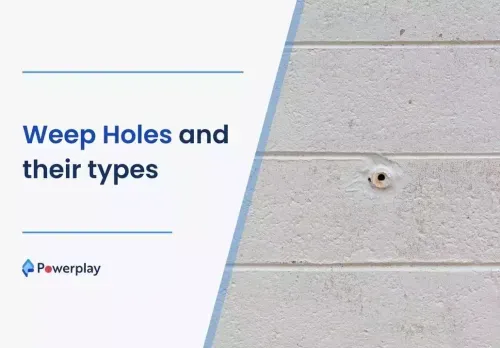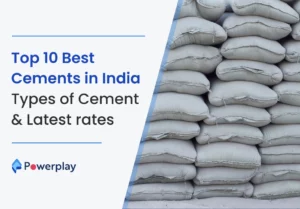Weep Holes and their types
-
Kumar Abhishek Anand
- October 11, 2023

Retaining walls, stone walls, wing walls, underpasses, etc. are equipped with weep holes to drain excess water introduced into the structure by capillarity, leakage, or infiltration. This moisture generally accumulates behind the wall but should be removed to prevent damage to the structure of the wall. Weep holes also act as a ventilator in masonry walls, allowing air to flow behind the wall to prevent mold, fungus, rot, and moisture buildup. All of these factors, when present on masonry walls, can adversely affect the life and function of the building structure.

Weep holes are also provided in cavity walls at regular intervals and below windows and above doors to allow moisture to escape from these openings. The standard distance between two horizontal weep holes for a cavity wall is 450 mm.
From a technical point of view, the main function of the weep hole is to relieve the hydrostatic pressure acting on the wall. Therefore, if weep holes are provided, the additional need for hydraulic and earth pressure in the structural design of the wall is ignored by reducing the wall thickness along with the need for reinforcement. The permeation holes then prevent the structure from being lifted, reducing buoyancy and allowing the construction of lighter building structures without worrying about stability issues.
Table of Contents
ToggleWhat Are Weep Holes?
Weep hole dimensions also need to be carefully designed to control surface tension.Weep holes are usually provided with the help of sand drainage channels that allow them to function properly. The number of weep holes that need to be installed in a wall structure depends on the size and length of the structure and the water table in the area.
Where are Weep Holes needed?
Depending on the groundwater level in the area, it is possible to explain where the weep holes need to be provided.
When the wall structure is built well above the water table, there is no possibility of water collecting behind the wall. Therefore, these structures do not need to relieve water pressure from weep holes.
When the wall structure is built below the water level, the saturated earth pressure of the water-soil mixture acts as a submerged earth pressure that is lower than the saturated earth pressure. Therefore, rather than providing weep holes, these structures should be designed to resist both soil and water pressure.
Finally, building a wall structure below the water table creates excessive water pressure on the wall structure. This additional hydrostatic pressure can be reduced by providing weep holes at the bottom of these structures.
The best location for weep holes in wall structures is at the bottom of retaining walls and masonry walls. Because at the lowest point of all structures, the principle of gravity allows water to escape. These weep holes also help ventilate the air behind the wall and are provided above the doors and under the windows to remove water.
Types of Weep Holes
Weep holes are mainly of 4 types that are:
01 – Open Head Joint Weep Holes
02 – Cotton Rope Wicking Weep Holes
03 – Tubes Weep Holes
04 – Corrugated Channel Weep Holes
01 – Open Head Joint Weep Holes
This type of weep hole is one of the most common types which are installed and are also quite effective in vaporizing water from the cavities. There is a weep hole in the upper joint to drain water only from the wall joint. They are made by removing the mortar from the vertical joints between the bricks. They are usually the same size as the standard 21-inch open head joint spacing.

A plastic drainage structure is provided around the drainage holes to prevent rain and inserts from entering the holes. A drip mechanism has been added to the front lip to support drainage. The standard spacing provided between the open head joint weep holes is 24 inches.
02 – Cotton Rope Wicking Weep Holes
As the name implies, these weep holes are formed using ropes that are less than 12 inches long. One end of the rope is placed at the joint and the other end extends to the wall of the cavity wall.
From the back of the wall, water is adsorbed on one end of the rope and evaporates on the other end of the rope. This process may seem very effective, but it’s very slow compared to other weep holes.
03 – Tubes Weep Holes
The drain of the pipe is installed at a slight angle to facilitate the flow of water through the pipe. Also, do not set the installation angle too steep. In addition, gravel may be laid thinly to prevent water from flowing from the clogged drain of the pipe.
04 – Corrugated Channel Weep Holes
Corrugated drain holes are based on the latest technology and can quickly pump water from numerous channels. These are usually at the bottom of the mortar bedding joint.
Functions of Weep Holes
Weep holes perform various functions some of which are:
01 – To reduce the hydrostatic pressure acting on retaining walls. This is the primary function of weep holes.
02 – To drain out rainwater entering into retaining walls or cavity walls.
03 – To prevent structures from getting uplifted and reduce buoyancy, thereby increasing strength and stability.
04 – To prevent dampness in walls which harms the integrity of the wall.
05 – To provide ventilation in retaining and cavity walls to prevent the formation of mold and fungus.
Share
Kumar is a digital content professional with more than 2 years of experience in Blog writing, copywriting and scripting. His passion lies in the art of creating convincing content that plays a major role in converting leads for SAAS businesses.












